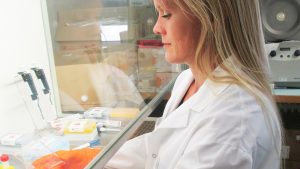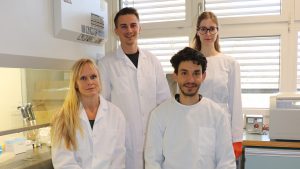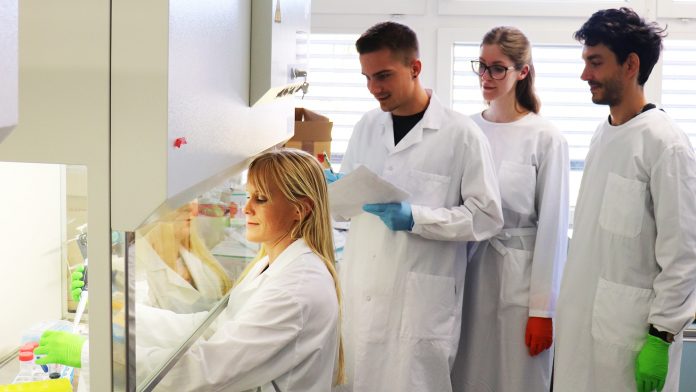Professor Dr Mirjam Schenk, Research Group Leader & Assistant Professor at the University of Bern’s Institute of Pathology, spoke to The Innovation Platform about her research into the signal molecule Interleukin-32 and how this could play a key role in future immunotherapies
The University of Bern’s Institute of Pathology covers the entire width of the morphological and molecular diagnostics of tissue samples. Research there deals with the development, diagnosis, and treatment of diseases. Immune pathologies, inflammatory diseases and tumour biology are the current research interests. Ex vivo studies of human tissue samples and the use of experimental in vitro and in vivo model systems are used to answer research questions.
The Innovation Platform spoke to Professor Dr Mirjam Schenk, Research Group Leader & Assistant Professor at the institute, about her research into the signal molecule Interleukin-32 (JCI Insight. 2020 Sep 17;5(18):e138772) and how exploring the entire immune landscape of myeloid and lymphoid lineage cells could result in new therapies to overcome the limitations observed in current clinical immuno-oncology.
How would you characterise the development of immune checkpoint inhibitors in recent years? What are their strengths and weaknesses?
In the past decade, the field of cancer immunotherapy has witnessed significant breakthroughs for the treatment of advanced tumours ranging from lung cancer to metastatic melanoma. Arguably, the most durable clinical outcomes have been achieved using monoclonal antibodies (mAbs) to block natural inhibitory checkpoints in T cell activation, such as CTLA-4 and the PD-1/PD-L1 axis. The development of immune-checkpoint inhibitors (ICI) as immunotherapy for cancer patients revolutionised the field of oncology on various levels and has revived the area of tumour immunology.
As the success of immunotherapy relies on the activation of the host immune system to destroy cancer cells, the development of ICI led to a more comprehensive view of the cancer, focusing more on the tumour microenvironment and the complex interplay between stromal, cancer, and immune cells. Drugs that mediate checkpoint blockades by targeting the inhibitory receptors CTLA-4 and PD-1/-L1 have shown objective responses for multiple cancer types, where they show high potency against cancer cells and increase the survival time of patients.
Despite the tremendous successes of ICI, to date, only a subset of patients achieve durable clinical responses and there is an unmet need to identify biomarkers that can predict the efficacy of a particular ICI treatment for each patient. In addition, immunotherapy has ushered in a new era of cancer treatment by offering the possibility of combining these drugs with conventional cancer treatments such as radiation, chemotherapy, or targeted molecular therapy (e.g. BRAF/MEK inhibitors).
The successful use of combined checkpoint blockade has also widened clinical interest in additional immune checkpoints some of which are undergoing preclinical or clinical investigation. Thus, immune checkpoint or agonistic antibodies have revealed a plethora of novel possibilities for cancer treatment. Future studies will involve analyses of various combinations aimed at developing immunotherapies tailored to the specific tumour immune contexture.
Due to the fact that immune-checkpoints play an important role in regulating immune responses and immunologic tolerance, the major toxicities associated with the use of ICI include a range of autoimmune symptoms, also known as immune-related adverse events (IRAE). The incidence of IRAE is quite high and requires careful management in the clinic with immunosuppressive medications. Another disadvantage of ICI is their relative high cost and the long treatment phase.
Could you describe the background to your work on signal molecule Interleukin-32? What is its double effect within and in the immediate area around a tumour?
While I was working in the laboratory of Professor R. L. Modlin (Dermatology, David Geffen School of Medicine, UCLA, USA), one of my main research focuses was to investigate the mechanisms of macrophage and dendritic cells (DC) differentiation and their contribution to the immune response in mycobacterial infections (tuberculosis and leprosy). Our studies resulted in a major discovery by identifying a novel pathway of DC differentiation: specific triggering of NOD2 induced an IL-32-dependent DC programme in leprosy patients, involving the up-regulation of DC maturation markers, co-stimulatory molecules, and augmented MHC class I antigen presentation function, including cross-presentation. Notably, IL-32 was sufficient to induce monocytes to rapidly differentiate into DC, which were more efficient than granulocyte-macrophage colony-stimulating factor (GM-CSF)-derived DC in presenting antigen to major histocompatibility complex (MHC) class I-restricted CD8+ T cells. In conclusion, the NOD2 ligand-induced, IL-32-dependent DC differentiation pathway contributes a key and specific mechanism for host defence against microbial infection in humans. These findings were published in Nature Medicine in 2012. Thus, IL-32 was posited to be a potential biomarker for protective immune responses in mycobacterial infections.
Our finding that IL-32 induces DC with enhanced MHC class I antigen-presentation and cross-presentation function, prompted us to further investigate the role of IL-32 in the immune response to cancer and as a potential tumour immunotherapy. These studies showed that in melanoma, IL-32 leads to the maturation and activation of DC, which play a key role in the initiation of tumour-specific immune responses. Upon maturation, these tumour-infiltrating DC then migrate to the draining lymph node where they can prime tumour-specific T cells.
In addition, we found that IL-32 also triggers macrophages to secrete high amounts of certain chemokines, which act as attractants for effector T cells. This pro-inflammatory, chemokine-rich tumour microenvironment induced by IL-32 treatment attracts T cells to enter the tumour where they can promote effector functions and eliminate tumour cells. This second effect of IL-32 on the TME was rather surprising and makes IL-32 a candidate molecule to turn a ‘cold’ tumour ‘hot’.

What were the main challenges in your research on signal molecule Interleukin-32 and how did you overcome them? What did the trial on mice show? What were the project’s biggest successes?
One of the biggest challenges in this study was the fact that the receptor for IL-32 has not been identified and no rodent orthologs of IL-32 have been reported. Consequently, all murine studies with IL-32 have been limited to transgenic mice overexpressing human IL-32 and to the use of recombinant human IL-32 in mice, which makes it difficult to assess the translational relevance of IL-32 treatment in these settings. Furthermore, in models with transgene-induced intracellular IL-32 expression, the protein may not be secreted and may therefore not accurately reflect its mechanistic role in human cancers. Even though no rodent orthologs of human IL-32 have been reported, we were able to show that human IL-32 triggers redundant signalling pathways, gene expression, and effector functions in human and murine cells. Hence, we investigated the therapeutic potential of intra-tumoural IL-32 administration in murine cancer models while simultaneously assessing the immunological correlates and prognostic value of high IL-32 expression in human melanoma.
The direct administration of recombinant IL-32 to established B16F10 murine melanomas resulted in significant reduction of tumour growth in primary treated and contralateral untreated tumours, suggesting the induction of systemic cancer immunity. In addition, IL-32 treatment induced enhanced chemokine levels within the tumour and increased the proportion of activated, tumour-specific CD8+ T cells. Furthermore, Batf3-dependent DC, CD8+ T cells, and CCR5-binding chemokines were found to be essential for IL-32 mediated control of tumour growth.
Most strikingly, our studies in the mouse model showed that IL-32 in combination with ICI (anti-PD-1) showed enhanced efficacy in the low immunogenic B16F10 melanomas versus either monotherapy, and gene expression of IL-32 was associated with response to ICI in human melanoma patients. Taken together, our study provides evidence for the use of IL-32 as a potent immunotherapy to overcome the non-T cell inflamed tumour microenvironment and widen the clinical application of ICI.
Bioinformatic analyses has demonstrated a statistical benefit in terms of improved life expectancy for melanoma patients. What do you plan to do next to build on this?
Our analysis of human melanoma samples revealed that high IL-32 gene expression is a strong predictor of survival in human melanoma patients and correlates with expression of DC maturation markers and an immune-inflamed tumour microenvironment (TME), which is generally associated with a better prognosis and better response to ICI. Furthermore, IL-32 treatment in mice resulted in increased expression of DC maturation marker and key chemotactic genes involved in the recruitment of activated T cells to the tumour. As such, IL-32 may be particularly relevant for modulating the tumour immune contexture towards a ‘T cell inflamed’ phenotype leading to improved anti-tumour responses and significantly enhanced activity of immune checkpoint drugs.
Based on these findings, IL-32 expression could be developed into a useful prognostic biomarker for patient outcome or a predictive biomarker for success of ICI treatment in melanoma. However, the process through which biomarkers are approved for clinical application is highly stringent. Therefore, the potential use of IL-32 as a predictive or prognostic biomarker in melanoma will be further investigated and validated.
In addition, the use of IL-32-based therapeutics will be further investigated and its prospects as a monotherapy and combinatorial synergy with established treatments will be dissected in future studies. We therefore aim to investigate the use of IL-32 nanomedicines that will be engineered with the help of our collaborators at EPFL, University of Lausanne.
Advances in the field of nanotechnology have furnished us with a plethora of drug delivery platforms to overcome current barriers to immunotherapy. One particular formulation that harbours promise for effective cytokine delivery is a ‘smart’ nanogel capable of triggered release. The capacity of these IL-32-based nanomedicines to improve responses to checkpoint blockade will be tested in various murine cancer models with distinct immunogenic profiles and response rates to checkpoint inhibitors.
The potential capacity of these IL-32 based nanomedicines to promote ICI mediated immunity in previously non-responsive mice may have clinical applicability also for cancer types which currently remain refractory to immunotherapies, such as pancreatic cancer. These IL-32-based nanomedicines will then be tested independently and in combination with immune checkpoint blockade as cancer immunotherapy in murine models and potentially in subsequent clinical trials and will yield essential information for targeting DC in vivo as a crucial component of future immunotherapies.

What do you hope to achieve in the long term, and where will your future research priorities lie?
In our future work I would like to combine our expertise on the functional differentiation of myeloid cells and their regulation by mycobacteria with our most recent work on tumour mouse models and human melanoma patient material. We will investigate the use of mycobacteria-derived agents in cancer immunotherapy as a cost-effective treatment option. It is known that mycobacteria can induce a strong immune response and can activate both the innate and adaptive arm of the immune system. As shown by us and others, the mycobacterial cell wall comprises a variety of immunogenic glycolipids, lipoproteins and glycans that can be recognised by patterns recognition receptors (PRR) – such as Toll-like receptors (TLR) and NOD-like receptors (NLR) – to provide maturation signals for macrophages and dendritic cells, favouring a pro-inflammatory tumour microenvironment. One of our major goals is to identify the cellular and molecular pathways underlying mycobacteria-induced tumour immunity and to unveil novel therapeutic targets. These prospective studies promise to provide mechanistic insights as well as rationale for the clinical translation of mycobacteria-derived agents in cancer immunotherapy and further clinical development of novel, more effective treatment modalities.
Overall, the research being performed in my group is multi-faceted and interdisciplinary, and we hope to harness our strengths and those of our collaborators to achieve new successes in translational immune-oncology. While we perform mechanistic studies in murine models, our primary goal is to reveal potential immunotherapy drug targets in human disease. Whereas the field of immunotherapy in cancer has focused primarily on T cells, we posit that examining the entire immune landscape of myeloid and lymphoid lineage cells will allow us to develop therapies which overcome the limitations observed in current clinical immuno-oncology. We aim to examine the role of various tumour-infiltrating leukocyte subsets on disease progression and response to treatment.
My ultimate research goal is the clinical translation of novel therapeutic targets, as well as of predictive and prognostic biomarkers or signatures.
Professor Dr Mirjam Schenk
Research Group Leader & Assistant Professor
Institute of Pathology
University of Bern
+41 (0)75 430 99 97
mirjam.schenk@pathology.unibe.ch
Tweet @unibern
www.pathology.unibe.ch
Please note, this article will also appear in the fourth edition of our new quarterly publication.







